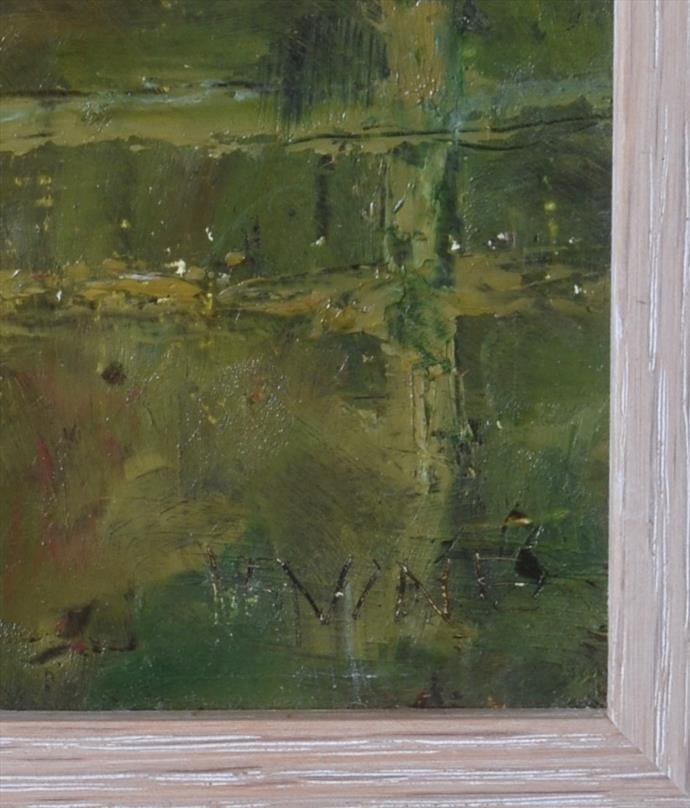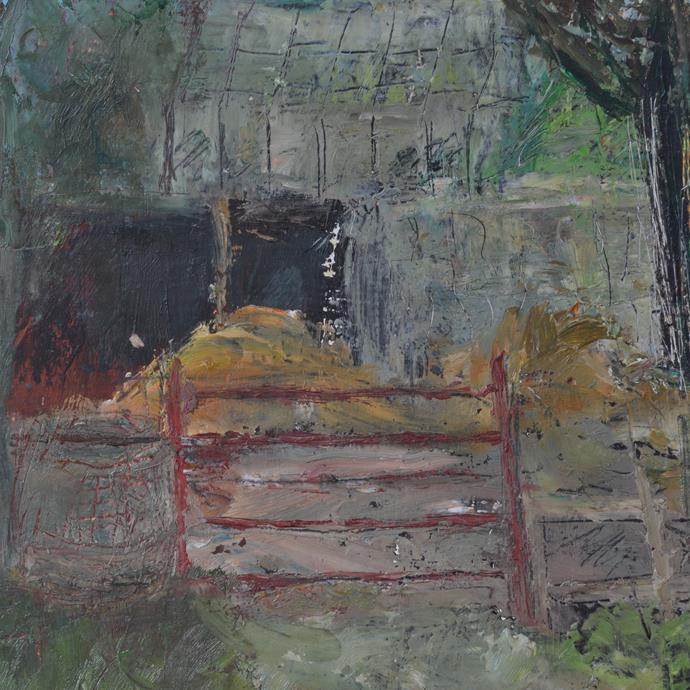The Smallholding Sylvia Levine
Amongst so many other marks scratched into the paint of this picture is the signature in capitals: ‘LEVINE’, in scruffy capitals, insistent, at speed. Straight away, we can feel that the artist has an intense, if brief, attachment to this evocative scene. She wants to convey this moment to her viewers.
Across the board, there are also other, hastily-inscribed lines, denoting the panes of the glasshouse, the fence and gates. Elsewhere, there is the lushness of the grass and canopies of trees – depicted with swift, succulent layers of citrus, parsley, emerald, ochre and fresh, new-leaf, green, itself scattered with pale sparkles of wildflowers. There is a recognition, here, that Man has been busy, has been building and farming and making: but Nature is winning. The small-scale of the man-made structures suggests the investment of just one or two people; the depth and pulsing variety of colour and life of trees and grasses and flowers embodies the perpetual, irresistible, cycles of Nature. There is love and wonder expressed in the fairly small compass of this painting; there is also a little melancholy, some anxiety,
We do not know the date of this picture: but it has much of the poetic, dream-like quality, the swift – even eccentric – execution and the intense, personal emotion that we also find in Summer at Downside, which was shown at the RA in 1990. Like the latter, we believe this picture to have been executed in the later year of Levine’s life, at a time when, perhaps, she spent less time with people and more time exploring the natural world as it was available – in all its variety and richness – in the landscapes which embrace Bristol. This picture, at first, suggests an allotment; a piece of managed land, where flowers and produce are grown in careful order. And, Redland Green Allotments, laid out on hilly farmland during the War, were just a short walk from where Levine lived, on Blenheim Road, Bristol. My first thought was that this painting could well offer a glimpse of the Redland Green site. But, this appears to be a much messier and muddier environment. It is a smallholding, and, as well as the slightly unsteady-looking greenhouse, there is, surely, a pigsty - a low, dark enclosure, supported simply on a few upright poles, perhaps built out of corrugated iron. On the ground just outside the sty there are piles of straw; just raked out, or awaiting someone to come and lay down fresh bedding for the pigs? In front of the piles of straw, there are even two or three long, horizontal brushstrokes. They cannot be called pigs; but they are the only slices of that peculiar fresh, milky pink hue which we associate with one of Britain’s most popular pig breeds, the Large White. Those slices of colour carry with them the promise of squealing, grunting, inquisitive, energetic animals. This is someone’s beloved small-holding, perhaps rented just for the summer, perhaps a place where generations have farmed and gardened? In either case, this little smallholding seems to be infused with the promise – the threat – of change: vegetation, people, animals, mud, structures built on-the-hoof, all poised beneath a soft, blue sky. Surely, this is all about to be recast? The slices of milky pink might suggest that the pigs are now gone; their bedding is no longer wanted; their sty might collapse as winter approaches; the glasshouse, fences and gates may not withstand the next bout of severe weather. The burgeoning grass and trees – already shaking in the wind? – are pulsing with life. To catch and convey so much meaning in this scene, with such a degree of wonder and passion, is powerful and compelling. This is Levine at her best.
37.5cms x 27cms
35cms x 42.5cms



